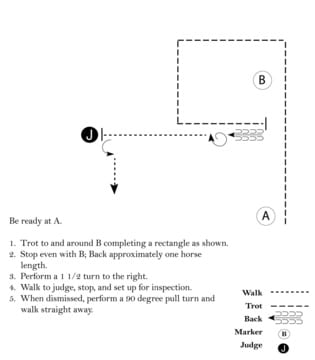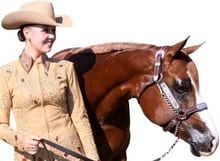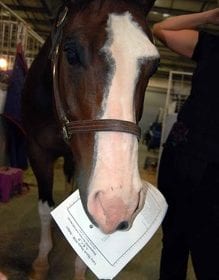AQHA judge, GoHorseShow.com reporter, and 18-time All-American Quarter
Horse Congress winner, Laura Gilmer discusses some of the important
parts of the Congress showmanship, horsemanship, and equitation
patterns. First up in the series: Breaking Down the Congress Showmanship Pattern.
This article will concentrate on the Amateur and 15-18 patterns since they are the most difficult (and the same) and have several of the same maneuvers as the lower divisions. Trotting square corners seem to be very popular this year and shows up in the showmanship and equitation patterns. In the horsemanship, jogging to an extended trot, extended lope to a slow lope, and extended lope to a stop are common maneuvers in the many of the patterns.
Specifically regarding the showmanship, there has been some discussion that the Amateurs have had the same Showmanship pattern at least three different times at the Congress, and some exhibitors have expressed that there needs to be a little more variety in the patterns. Many competitors have done this showmanship pattern before so there is no excuse for them to not know the pattern!
Several Amateurs I spoke with were excited to learn that they are showing the showmanship in the Celeste Arena this year instead of the Coliseum which they have done for the past few years, or the tiny Cooper Arena, home of the 2006 Amateur Showmanship.
Showmanship
Click Here to View Pattern in Separate Window
Pattern courtesy HorseShowPatterns.com
As a judge, I look for a confident showman with the smoothest pattern. I don’t care for artificial smiles, postures or running stances. The more natural the better. A classy well fitted outfit with little, if any, bling would work fine for me. I prefer all the maneuvers to connect as one smooth pattern rather than starting and stopping between each maneuver. Straight lines are a must. Lastly, I want someone to take the time to have a correct set up even if it takes a little bit more time.
I will walk through the Congress showmanship pattern from the very beginning and tell you my thoughts as I am reading the pattern.
 1. Be Ready at A. Make sure you are ready at the cone and not have the judges waiting for you to set up to begin your pattern. I want to see natural confidence at the first cone and I want you to tell me with your body language that you think you deserve to be the winner. The trot off is your first opportunity to really make a strong first impression. As a judge, I am really impressed when the exhibitor is able to get their horse to begin their trot from a complete standstill with no walk steps and zero movement from their hands. The horse that pays attention to their human partner’s movement and goes effortless into the trot will be highly rewarded.
1. Be Ready at A. Make sure you are ready at the cone and not have the judges waiting for you to set up to begin your pattern. I want to see natural confidence at the first cone and I want you to tell me with your body language that you think you deserve to be the winner. The trot off is your first opportunity to really make a strong first impression. As a judge, I am really impressed when the exhibitor is able to get their horse to begin their trot from a complete standstill with no walk steps and zero movement from their hands. The horse that pays attention to their human partner’s movement and goes effortless into the trot will be highly rewarded.
The exhibitor’s trot stance is very important to me. I do not like competitors who are very stiff and have straight arms, whose shoulders are hunched forward, and, also a showman who bend their knees and has a very artificial look while they are running. No duck trot, please! Also, while I do not want a stiff look, the exhibitor also needs to take care in not swinging their shoulders side to side when trotting.
 One of the important maneuvers in the pattern is trotting the square corners of the rectangle. What I am looking for in a top showmanship pattern is when the exhibitor
One of the important maneuvers in the pattern is trotting the square corners of the rectangle. What I am looking for in a top showmanship pattern is when the exhibitor
and their horse are moving together as one team and the trot and trot corners are a place
to show me you are a team. According to Amateur competitor Kaleena Weakly, it is important to maintain the same speed through the corners. “Some exhibitors tend to slow down trying to make the corners square. It makes it more difficult and breaks up the cadence and smoothness of the pattern.”
I agree with Weakly’s comments. I like for the exhibitor to maintain the same speed throughout the pattern. The exhibitor who slows down through the corners shows a lack of confidence and the pattern has a more inconsistent, less polished feel. Also, some exhibitors may feel that we will reward the showman that trots the fastest rectangle. That would actually be considered a negative maneuver if it looks spastic and hurried. So a smooth consistent pace throughout this maneuver is the most desirable.
 2. Stop even with B; Back approximately one horse length. I want a clean, crisp stop with your horse’s nose even with cone B. The back is where I see many people get off track in their pattern. The horse either swings its hip when it stops and they end up crooked or they back crooked and with resistance. The horse doesn’t need to run backward, but the horse needs to show zero resistance during the back. I prefer an exhibitor who is able to keep their left hand in one place during the entire back. In this pattern especially, the back needs to be completely straight. Multiple Congress and World Show top-10 Amateur, Beckie Peskin who shows Rocked On The Rail under the guidance of Robin Frid says, “A straight back is a necessity because there is a small window of where your horse can be entering the spin to make sure you come out straight to the judge.”
2. Stop even with B; Back approximately one horse length. I want a clean, crisp stop with your horse’s nose even with cone B. The back is where I see many people get off track in their pattern. The horse either swings its hip when it stops and they end up crooked or they back crooked and with resistance. The horse doesn’t need to run backward, but the horse needs to show zero resistance during the back. I prefer an exhibitor who is able to keep their left hand in one place during the entire back. In this pattern especially, the back needs to be completely straight. Multiple Congress and World Show top-10 Amateur, Beckie Peskin who shows Rocked On The Rail under the guidance of Robin Frid says, “A straight back is a necessity because there is a small window of where your horse can be entering the spin to make sure you come out straight to the judge.”
3. Perform a 1 1/2 turn to the right. I prefer an exhibitor who goes straight into the turn from the back without having to hesitate first. The turns need to flow, and the horse needs to be straight in its body and neck and plant the correct foot during the entire turn. Know where your horse is and be sure to complete your turn — do not under spin or over spin as this will cause you to not be straight to the judge. I also like to see the exhibitor walks right out of the turn in a confident manner straight to the judge.
4. Walk to judge, stop and set up for inspection. The set up is a place where I see many competitors rush and try to set up too fast. I like to see a confident showman who has the patience to get their set up square and correct even if it takes a little bit more time than a competitor that tries to rush it has a poor set up–one where the horse’s feet are off set, too wide, or too close to each other. Also, you need to find an adequate distance from the judge to set up. Try not to stop too close or too far away from the judge. I like a showman that is very natural in their crossovers who doesn’t look rushed or nervous or unsure of their foot placement. I prefer an understated smile that gives me the impression that they know what they are doing–not a put on, teeth barring artificial smile that makes some judges including myself cringe.
5. When dismissed, perform a 90 degree pull turn and walk straight away. A common mistake people make is not having enough forward motion in the pull turn which results in the horse taking a step back. As far as the handler goes, much like everything in the showmanship, if it’s not perfect, don’t let your body or face tell on you. Walk straight out. Please do not nod or make any exaggerated or unnatural body movements.
So, in conclusion–the smoothest, straightest pattern with a confident natural showman communicating effortlessly with their horse will be at the top of my card. Best of luck to all showmanship exhibitors!








